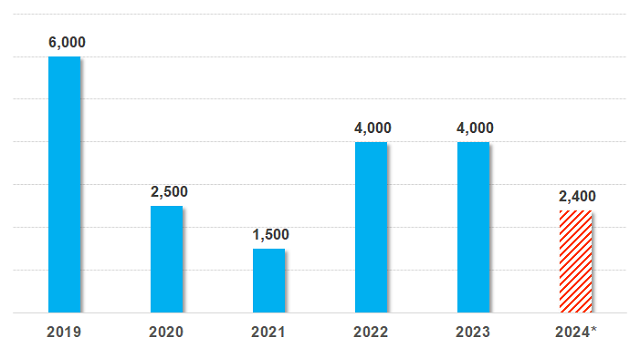
Experts discuss at the workshop. Photo: Tu Kinh
|
On April 23rd, at the event C-Talk with the topic “Agility in Technology Application Leading to Excellent Operation” organized by Finance – Banking Block of FPT Information System and FPT Smart Cloud in coordination with the automation solution akaBot, Director of Digital Banking Block of Saigon Thuong Tin Commercial Bank (Sacombank, HOSE: STB) Mr. Tran Thai Binh stated that the implementation of digital transformation in banks is almost the same in terms of methods and strategies, but it will vary according to the current situation, especially regarding personnel.
According to Mr. Binh, talents in digital transformation are in great shortage and have become a challenge for any organization, not just STB, while technology is just a part of it. Another challenge lies in the digital mindset, as it is extremely difficult to develop one.
Mr. Luong Tuan Thanh, Director of Technology and Digital Transformation Block of Phuong Dong Commercial Bank (HOSE: OCB), observed that financial banking services are now available everywhere. For example, QR codes can be scanned to make payments at markets and coffee shops. And that has become the greatest challenge for banks: how to provide services to customers anytime, anywhere.
How have banks started?
With the assistance of IBM, STB has repositioned its vision of becoming a digital organization in the future by answering questions.
For instance, What needs to be done to achieve operational excellence? What needs to be done to provide a flawless experience, or if we want a digital technology platform that is flexible, agile, but secure, and follows the “Cloud First” strategy (strategy prioritizing the use of cloud computing technology)? What needs to be done to build a digital culture within the organization? How will personnel and processes be optimized in the future? How do we need to adapt to new ways of working?, etc.
The bank implemented this through a pilot approach, by trial and error, and then continued to learn and correct mistakes as well as apply the smallest things, striving to follow the concept of “Think big & start small”.
Since 2021, STB has started to apply new methods of working, specifically by redesigning the entire customer experience journey. For example, applying “Design Thinking” to understand what customers want or doing anything with the customer in mind, etc.
“In the past, we often thought that launching a product would be very difficult and risky, but now that mindset has changed. We started with a Digital Transformation Center, and now it’s the Digital Banking Block and are gradually expanding to other departments. We try to pass on the culture and new ways of working to the remaining units. That’s how STB did it despite facing many difficulties”, Mr. Binh shared.
With OCB, the bank also started with very basic issues. Digital transformation technology helps banks generate revenue, improve customer experience, optimize costs, mitigate risks, and ultimately build long-term competitive advantages.
According to Mr. Thanh, OCB started digitizing from the very simplest things and from about 10 years ago, such as paper-based operations, and then moved on to implementing systematic risk management models.
The next two important milestones were OMNI Banking in 2018 and Open Banking developed from 2019 because by this time the bank had taken shape with the desire that OMNI Banking would bring a unified experience to customers across both “online” and “offline” channels.
As for Open Banking, it has now been 5 years and this is also the greatest development foundation of OCB because now customers have very clear needs, through many channels, many daily activities such as scanning QR code payments.
“In the past it was very difficult, but now it is clear that using Open Banking will be a channel of exponential growth for many banks”, the expert admitted.
Digitizing processes is a difficult task
Regarding the digitization of processes, the Director of Digital Banking Block of STB acknowledged that the bank has started this for more than 2 years now and has encountered many difficulties. For example, which process will be the priority process? And how do we determine which process is the priority process to digitize? And how do we optimize it before putting it on the digital platform?
People often think that the daily operating process has been very optimized. Thus, the question arises of how to optimize it further and who is capable of assessing the process has been optimized before moving it to the digital platform.
Mr. Binh’s experience shows that it’s impossible to know which step is stuck, so the process must be put on a digital platform and then there will be data to track to know which step is stuck, not yet resolved, and which process with the most interactions with customers will be prioritized. For example, the “onboarding” process (which can be understood as the official start of a consensual relationship between a customer and a bank).
Previously, it took an employee about 30 minutes to access the system to create a customer code, open an account, open a card, open internet banking, etc., but now it can be shortened to about 7 minutes thanks to the automation of the process using robots (RPA).
“Honestly, at first we were also very confused about choosing the priority process and how to implement it. Should we optimize first or put it on the digital platform first?”, said Mr. Binh.
Sharing the same view, the Director of Technology and Digital Transformation Block of OCB said that the bank would still choose the process that has the greatest impact and the shortest implementation time. However, the specific characteristics of the bank are also related to compliance and risk criteria, which are always the top priorities because they can affect business operations; therefore, some processes need to be implemented first.

Mr. Luong Tuan Thanh shared his thoughts at the workshop. Photo: BTC
|
Robots can help process 500,000 transaction orders per day
According to Ms. Chu Hong Hanh, an expert in digital transformation in the banking and finance sector, robots on their own do not create a great impact, but when robots are combined with other technology groups to optimize like RPA, they can create a huge impact that could not be achieved before.
With the support of robots, a bank employee can process about 500,000 transaction orders a day. The bank of this expert has recorded a 3-fold increase in customer growth over the past two years while the number of employees has remained unchanged.
“Clearly, the role of robots cannot be denied”, Ms. Hanh affirmed.
According to Mr. Binh, when STB applied RPA to shorten processes but it did not meet the expectations of the leaders, they set a goal to automate more. To date, the bank is implementing almost entirely through RPA, eliminating the slow robot steps. However, not all systems can apply RPA.
Currently, customers coming to STB only need to use their citizen ID cards to scan. The system will automatically recognize and fill in all the information on the bank employee’s smartphone. When this customer wants to open a card, such as a debit card, the employee only needs to click a button and send the information template, and it will be done in less than a minute.
In addition, the bank has successfully integrated the verification of customers’ citizen ID cards (CCCD) with chips, ensuring 100% real people and real actions and receiving feedback from the Ministry of Public Security.
Specifically, customers only need to come and scan their CCCD, and the system will automatically take pictures, automatically retrieve information and proceed with verification. As for platforms that are too old and cannot do this, the bank will combine them with robots. For example, the “onboarding” process for customers right at the counter.
<







































